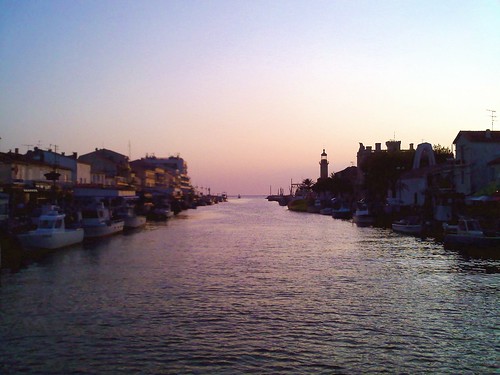 It's said that the Roman engineer Peccius was the first to organize the salt production efforts in the Camargue. The natural salt marshes and higher-than-normal natural salt content make the region an obvious place to harvest sea salt. In Aigues-Mortes, 500,000 tons of salt are distributed annually. While some of the process occurs naturally, capturing the quantities of salt demanded by market requires an engineered process.
It's said that the Roman engineer Peccius was the first to organize the salt production efforts in the Camargue. The natural salt marshes and higher-than-normal natural salt content make the region an obvious place to harvest sea salt. In Aigues-Mortes, 500,000 tons of salt are distributed annually. While some of the process occurs naturally, capturing the quantities of salt demanded by market requires an engineered process. First the salt is collected into vast evaporation pools. More than 45 million cubic meters of sea water must be pumped during the month of march. Throughout the spring, the evaporation process increases the concentration of salt 9-fold to 260 grams per liter. By mid-summer a thick cake begins to form on the surface of the water. The concentrated brine can grow to 20 cm thick, 9 cm of which is harvested as sea salt. The top of the cake takes on a bright red hue due to the presence of a special kind of algae which turns brighter as the salt concentration increases. Some of the algae and waste sediment can be collected and used as fertilizer, while lower quality salt is sold for road de-icing.
First the salt is collected into vast evaporation pools. More than 45 million cubic meters of sea water must be pumped during the month of march. Throughout the spring, the evaporation process increases the concentration of salt 9-fold to 260 grams per liter. By mid-summer a thick cake begins to form on the surface of the water. The concentrated brine can grow to 20 cm thick, 9 cm of which is harvested as sea salt. The top of the cake takes on a bright red hue due to the presence of a special kind of algae which turns brighter as the salt concentration increases. Some of the algae and waste sediment can be collected and used as fertilizer, while lower quality salt is sold for road de-icing.In September, the salt is harvested. Quality control measures ensure that the product is 99.5% pure sodium-chloride. Some salt is shipped on flat bottom barges along the shallow canals to the port, while another portion is loaded onto rail cars and sent in land. Several special bridges and conveyor systems are placed in service specifically for the once-a-year collection.
 Three major brands are harvested in the Camargue, including Le Saunier de Camargue and La Baleine. Ironically, they are all owned by the same parent company. Many of these brands are widely available in the US.
Three major brands are harvested in the Camargue, including Le Saunier de Camargue and La Baleine. Ironically, they are all owned by the same parent company. Many of these brands are widely available in the US.Having harvested salt from these marshes for over a thousand years, the Camargue salt farmers have struck a symbiotic balance with nature. While many industrial processes pose a threat to the local ecosystem, salt farming in the Aigue-Mortes salt marsh has actually demanded preservation of the indigenous wetlands. Of course, the salt companies probably exaggerate the extent of this success. Nevertheless, it is a model living sustainably with nature.
![Reblog this post [with Zemanta]](http://img.zemanta.com/reblog_e.png?x-id=b9a78167-b906-4578-9dd8-af2583d81dd1)



![Reblog this post [with Zemanta]](http://img.zemanta.com/reblog_e.png?x-id=2afdd1ec-6ef3-4a7c-8482-02b26bb912bf)
